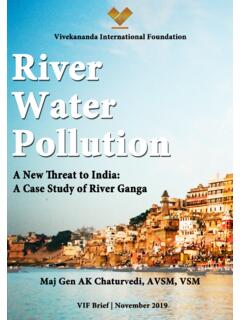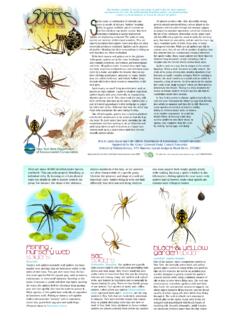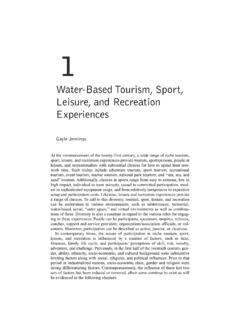Transcription of Lesson Plan: Yucky Water! A Water Quality Lab Investigation
1 1 Lesson Plan: Yucky Water ! A Water Quality Lab Investigation Laurie Rogers: Northview High School, Johns Creek, GA, Fall 2013 Pages 1-4 Lesson Plan outline Pages 5- 9 Student Lab Sheet & Evaluation checklist handout Page 10 Teacher notes Learning Objectives To become aware of how chemistry concepts learned in class can be used with a real world application pertaining to Water Quality . To learn how to follow correct experimental procedures to test for pH, dissolved oxygen, nitrates and phosphates in Water samples and to interpret and evaluate the data obtained to look for evidence of the source of pollutants. To be introduced to environmental science concepts such as watersheds, runoff, and Water pollutants, and the implications of eutrophication due to increased nutrient levels. To realize the importance of being good stewards for our waterways. Enduring Understandings for the Lesson : The importance of fresh Water , sources of Water pollution and implications of pollution on the health of our waterways.
2 Introduction to the Water Quality tests to be conducted, what each test measures, how each test is performed and the significance of test results. These tests will include qualitative observations, pH, dissolved oxygen, nitrates and phosphates. Lesson Overview: Students will read a scenario in which they pretend to be interns at an environmental consulting firm and will analyze Water samples to attempt to determine the type and cause of a polluted, locally collected Water sample. Students will do a pre-lab assignment to learn related vocabulary and investigate the importance of Water Quality testing and sources and effects of Water pollutants. Students will conduct Water Quality testing on tap Water and stream Water (collected by teacher and brought to school).and on samples to which pollutants have been added (fertilizers, household detergents, decomposed organic matter), as well as an unknown contaminated Water sample.
3 Ideally, students could collect Water samples if the school has a stream on-site or within a short walk. If not, students will use samples the teacher collected the day previously. Students will answer lab questions, some of which pertain to the chemistry of the tests, and will prepare a report to their fictitious supervisor, in which they will interpret and evaluate test data, and draw conclusions as to the origin of a contaminant in their Water samples. Georgia Performance Standards Addressed: Unit 1 Characteristics of Science: Habits of Mind SCSh2. Students will use standard safety practices for all classroom laboratory investigations. SCSh3. Students will identify and investigate problems scientifically. c. Collect, organize and record appropriate data. 2 f. Evaluate whether conclusions are reasonable by reviewing the process and checking against other available information. SCSh4.
4 Students will use tools and instruments for observing, measuring, and manipulating scientific equipment and materials. SCSh8. S tudents will understand important features of the process of scientific inquiry. b. Scientific researchers are expected to critically assess the Quality of data including possible sources of bias in their investigations hypotheses, observations, data analyses, and interpretations. Chemistry GPS SC1 Students will analyze the nature of matter and its classifications b. Identify substances based on chemical and physical properties. d. Use IUPAC nomenclature for both chemical names and formulas SC2 Students will relate how the Law of Conservation of Matter is used to determine chemical composition in compounds and chemical reactions. a. Identify and balance the following types of chemical equations: Synthesis Double Replacement b. Experimentally determine indicators of a chemical reaction specifically precipitation, gas evolution, Water production, and changes in energy to the system.
5 SC7. Students will characterize the properties that describe solutions and the nature of acids & bases. a. Explain the process of dissolving in terms of solute/solvent interactions b. Compare, contrast, and evaluate the nature of acids and bases: pH Environmental Science GPS SEV2. Students will demonstrate an understanding that the Earth is one interconnected system. d. Characterize the components that define fresh- Water and marine systems. Abiotic Factors to include light, dissolved oxygen, phosphorus, nitrogen, pH and substrate. SEV5: Students will recognize that human beings are part of the global ecosystem and will evaluate the effects of human activities and technology on ecosystems. e. Describe the effects and potential implications of pollution and resource depletion on the environment at the local and global levels ( Water pollution). CCGPS Literary Standards L9-10 RST3: Follow precisely a complex multistep procedure when carrying out experiments, taking measurements, or performing technical tasks.
6 L9-10 RST4: Determine the meaning of symbols, key terms, and other domain-specific words and phrases as they are used in a specific scientific or technical context relevant to grades 9 10 L9-10 WHST4: Produce clear and coherent writing in which the development, organization, and style are appropriate to task, purpose, and audience. Grade Level: High School 9-12 (Chemistry class) Materials: Access to internet for out-of-class research Water Quality testing kits: o LaMotte test kit: Shallow Water precision monitoring series, Code 5854-01. This kit contains supplies for performing dissolved oxygen test and pH o Universal Indicator solution (Flinn Scientific, 500 mL bottle, U0002) & color comparison chart o Nitrate and phosphate test kits: several options depending upon available funds: Freshwater Pollution Test Kit, Flinn AP5953 from Nitrate test kit color cube model N1-11 or N1-14 from 3 Phosphate test kit color cube model or PO-19 from PondCare Master Liquid Test Kit available through Basic laboratory glassware (beakers, test tubes) & safety equipment (splash goggles, gloves) Water samples (tap, stream, and polluted, see Teacher Notes at end of Lesson ).
7 Time Needed: Assign pre-lab homework 2 days before lab 15 minutes to review pre-lab homework and to introduce activity day before lab 60-minute class period for lab activity 15 minutes for post-activity class discussion the day after lab Outside class time for students to answer pre-lab and lab analysis questions and write report Background Information: Freshwater flowing across the earth s surface and into streams, rivers, lakes, and wetlands is one of our most precious resources. Freshwater is continuously purified and recycled through the Water cycle. The region into which surface Water drains is called a watershed. Surface runoff is Water that does not evaporate into the atmosphere or soak into the ground. This system works wonderfully; however, Water systems can be overloaded with contaminants. Water pollution is any chemical, physical or biological change in Water Quality that harms living organisms and makes it unsuitable for intended uses.
8 Point sources of pollution can be traced to a specific location, for example, sewage treatment plants, while nonpoint sources cannot be traced to a single discharge site, for example, runoff from croplands or lawns. The addition of nutrients to waterways is called eutrophication, and can derive from natural sources (organic decay) and human sources (fertilizer, pesticides, sewage, mining and industrial discharge, and urban runoff from substances such as motor oil). It is important to test the Water in our streams, rivers and ponds to monitor the health of the watershed. Water is tested for dissolved oxygen content, which is a measure of the amount of oxygen dissolved in the Water that is available for respiration by aquatic organisms. Acidity is a measure of the hydrogen ion concentration of a solution and is expressed as pH which is log[H+] with a scale of 0- 14, with 7 as neutral, <7 acidic, and >7 basic.
9 Nitrogen and phosphorus are necessary nutrients for plant growth, and a measure of nitrate (NO3-) and phosphate (PO43-) concentration above acceptable limits can tell us if there is pollution. The pollutants that could originate from a golf course, subdivision and farmland are organic matter such as grass clippings, fertilizer runoff containing nitrogen and phosphorus, and animal waste. A forest could have decaying organic matter runoff, and a restaurant which lacks proper sewage disposal could have contamination from phosphate-containing cleaning agents and detergents. Nutrient overload of a waterway produces excessive growth of algae and other aquatic plants, which increases the demand for oxygen, depleting the supply of dissolved oxygen. Increased photosynthesis also decreases the carbon dioxide concentration, leading to an increase in pH above the healthy range. A pH that is too low or too high can kill aquatic organisms.
10 Decomposition of excessive growth of aquatic plants by aerobic bacteria also depletes the supply of dissolved oxygen. This oxygen depletion can kill fish and other aquatic organisms. Prior student knowledge includes safe and proper chemistry lab technique, ability to write and balance chemical equations, and an understanding of chemical reactions, acidity and solubility. Learning Procedure: Refer to attached Student Lab Sheet for activity details, instructions and evaluation. 4 Evaluation: Refer to scoring checklist included at end of lab sheet. A teacher key is included for lab questions. Students will be evaluated on the following: 1. Vocabulary and pre-lab questions completed 2. Complete lab sheet with lab analysis questions thoughtfully and accurately answered. 3. Written report assessed for writing skills, strength of argument and supporting evidence. Extensions: 1. Research green alternatives to traditional fertilizers, pesticides, and cleaning products and cite the advantages and disadvantages of using these compared to traditional products.






